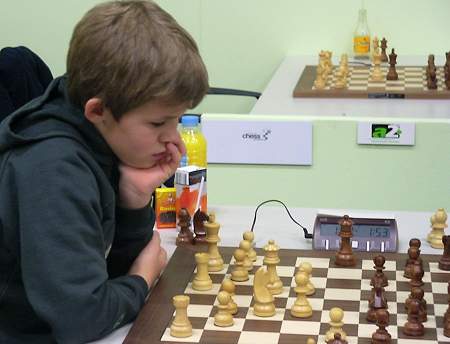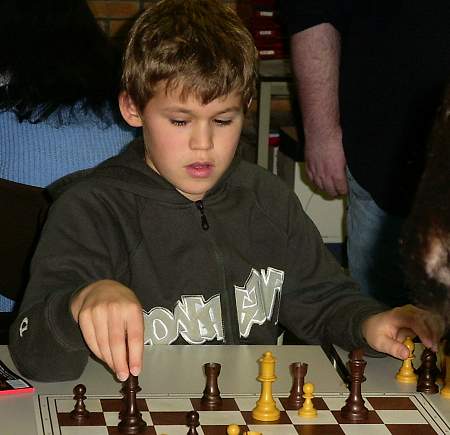Mega Magnus in Wijk aan Zee
A portrait of Magnus Carlsen by Mathias Berntsen
One of most interesting stories from this years Corus Chess Tournament did
not take place in Group A where the best of the best are playing, but rather
in Group C. A young and relatively unknown boy named Magnus Carlsen (13) from
Norway had his international breakthrough by winning Group C.

After round seven it was already clear that this was Carlsen’s tournament.
After dealing with an inferior position and being under heavy pressure by GM
Merab Gagunashvili (GEO 2583), Carlsen managed to counter-attack and win the
game, securing his first GM norm.

Thirteen year old Carlsen did not let the GM norm slow him down. Other than
a small hiccup in round nine, where he lost to GM Dusko Pavasovic (SLO 2615),
he managed to get 10.5 points, winning Group C half a point ahead of IM Sipke
Ernst (NED 2474). Scoring 10.5/13 in this group is in fact a performance of
2702! And his FIDE rating looks to be around 2550 in the next list. Not bad
at all.

Click table to enlarge
The most exciting match was in the penultimate round, where he played Ernst,
with whom he was sharing the number one spot. This was no short draw. Instead
Magnus checkmated his main rival in 29 moves, one of the most beautiful tournament
clinchers in recent years. The game, which is annotated below, earning Magnus
Carlsen a “spectators' prize”.

Magnus in 2001 (aged ten) |
Magnus Carlsen played in his first tournament when he was eight. Relatively
late some might say, but his development has been dramatic. His talent was
discovered immediately and Norway’s best player of all time, GM Simen
Agdestein, took on the task of training him. This has proven very successful
and with Magnus’ never ending enthusiasm and desire to learn, the results
came quickly.
Magnus participated in both World and European Youth Championships (age divided
groups), and his best result came in Crete, Greece in November 2002 where he
finished second with 9 points (he lost on tie-breakers to his arch-nemesis:
Ian Nepomniachtchi RUS 2433).
Already a star in the chess community in Norway, Magnus is a very well liked
kid. He has a smile and natural charm that people love. Often he is observed
playing with a football while waiting for his opponent to find a move (or resign).
In order to keep developing his chess he has to work very hard. Until recently
it was 2-3 hours a day, now-a-days it is more like 4-5 hours. He spends many
hours reading chess books (which he loves), playing on the Internet and training
with his tutor. In addition, he also loves to play football, go skiing and
even ski jumping! Scary.
 To
give him the opportunity to develop his talents his parents have sold their
second car, rented out their house, and for a year they will be traveling around
the world so Magnus can participate in chess tournaments. Magnus’ school
work is not neglected at all, but it has to be done in the back seat of a car,
in hotel rooms, etc. Both his father and sisters participate in some of the
tournaments as well. Traveling around to chess tournaments in different countries
is not at all cheap, and it would not have been possible without financial
aid. Luckily he has now found a sponsor (Microsoft).
To
give him the opportunity to develop his talents his parents have sold their
second car, rented out their house, and for a year they will be traveling around
the world so Magnus can participate in chess tournaments. Magnus’ school
work is not neglected at all, but it has to be done in the back seat of a car,
in hotel rooms, etc. Both his father and sisters participate in some of the
tournaments as well. Traveling around to chess tournaments in different countries
is not at all cheap, and it would not have been possible without financial
aid. Luckily he has now found a sponsor (Microsoft).
Magnus' memory is said to be photographic. His coach did a little stunt for
some journalists: on TV he showed the boy a diagram from a position in a chess
book Magnus immediately replied which game it was, from which book, and roughly
how it went. His father also has stories of five year old Magnus reciting the
name, size and population of all the 430 counties in Norway. This ability is
undoubtedly very useful when keeping up-to-date on modern opening theory. One
might assume this has been vital when building up his amazing opening repertoire.
Magnus Carlsen is being called “without a doubt the most gifted talent
in Western Europe at this time”. He is clearly a player we will see more
of in the years to come. Fans can already start looking forward to the next
Corus Chess Tournament, where Magnus will be playing in Group B (he qualified
directly by winning Group C this year). So, how far can he go? Interesting
question. His coach is sure he is 2700+ material and that he might play for
the World Championship title one day. That might be true, but there are many
obstacles and difficulties to overcome, and numerous things might get in the
way. He is still so young, and young people change fast. Perhaps he will suddenly
stop improving and grow tired of chess altogether. Let’s hope not. Luckily
there are no indications of this yet. He seems hungrier than ever.
Carlsen,M (2484) - Ernst,S (2474) [B19]
GMC Wijk aan Zee NED (12), 24.01.2004 [Annotations by André Schulz]
1.e4 c6 The Caro Kann Defence has become more popular in
recent times, with a lot of new ideas appearing. 2.d4 d5 3.Nc3.
The boom of the Advance Variation with 3.e5 seems to be over. 3...dxe4
4.Nxe4 Bf5 Until recently the most popular alternative was 4...Nd7
4...Nd7. 5.Ng3 Bg6 6.h4 h6 7.Nf3 Nd7. In recent years Black
has been experimenting with 7...Nf6. The idea is to allow the white knight
to get to e5 and then to use c6-c5 to undermine its position there and attack
it. 8.Ne5 Bh7 9.Bd3 Bxd3 10.Qxd3 e6.

8.h5 Bh7 9.Bd3 Bxd3 10.Qxd3 e6. 10...Qc7 allows Black to
prevent the next white move and at the same time prepare for long castelling.
But the black queen is now committed. After the text move Black wants to castle
kingside.
11.Bf4 Ngf6 12.0-0-0 Be7 13.Ne4 Qa5. Or 13...Nxe4 14.Qxe4
Nf6 15.Qd3 (15.Qe2). 14.Kb1 0-0 15.Nxf6+ Nxf6 16.Ne5 Rad8 17.Qe2 c5.
18.Ng6! fxg6. 18...Rfe8 19.Nxe7+ Rxe7 20.dxc5 wins a pawn.
19.Qxe6+ Kh8 20.hxg6! now there decisive threats of a devastating
sacrifice on h6. 20.Qxe7 Nd5 21.Bd2 Qxa2+ 22.Kxa2 Nxe7 is less convincing.
20...Ng8 seems to protect e7 and h6. Lubos Kavalek points
out that after 20...Rd7 the stunning rook sacrifice 21.Rxh6+! leads to a mating
attack after 21...gxh6 22.Bxh6 Rg8 23.Qf7! cxd4 24.Bg5 Qxg5 25.Rh1+ and mate
in two to follow; and on the other hand 20...Rde8 allows 21.Rxh6+! gxh6 22.Bxh6
Rg8 23.Rh1 Rxg6 24.Bf8+ winning.
21.Bxh6! gxh6. 21...Nxh6 22.Rxh6+ gxh6 23.Qxe7 with a forced
mate on h7. 22.Rxh6+ Nxh6. 22...Kg7 23.Rh7#. 23.Qxe7
Nf7.
It is interesting to note that this position already occurred in the game
Almagro Llanas-Gustafsson, Pablo Gorbea 2003. The game ended after 24.Qf6+
Kg8 25.Rh1 Nh6! 26.Qe7 (26.Rxh6 is impossible because of 26...Qe1#) 26...Nf7
27.Qf6 in a draw.

Magnus analysing the position with his opponent after the game
24.gxf7! This is the novelty played by young Carlsen. 24...Kg7.
The black king is helpless against the onslaught of White's heavy artillary.
25.Rd3 Rd6 26.Rg3+. Not 26.Qxd6 because of 26...Qe1+ and mate.
26...Rg6 27.Qe5+ Kxf7 28.Qf5+ Rf6 29.Qd7# 1-0.

What a beautiful "epaulette mate"! This game brought Magnus Carlsen
the audience brilliancy prize in Wijk aan Zee.
- Click here
to replay and download the above game, as well as all others played by Magnus
Carlsen in Wijk aan Zee.
Credits
Mathias Berntsen, 27, lives in Oslo, Norway
and is a Customer Service Manager for (yeah!) Opera
Software. As his hobbies Mathias lists Chess – he is a member of
the Akademsik Sjakklubb Oslo – movies, music, food, computers.
All pictures on this page by Aniko Kiss of Business
Basics, Holland, who visited the tournament in Wijk for us.
André Schulz is the resident editor of www.chessbase.de.
The German ChessBase news page has independent content and should be visited
by anyone who understands even a smattering of the language.






















 To
give him the opportunity to develop his talents his parents have sold their
second car, rented out their house, and for a year they will be traveling around
the world so Magnus can participate in chess tournaments. Magnus’ school
work is not neglected at all, but it has to be done in the back seat of a car,
in hotel rooms, etc. Both his father and sisters participate in some of the
tournaments as well. Traveling around to chess tournaments in different countries
is not at all cheap, and it would not have been possible without financial
aid. Luckily he has now found a sponsor (Microsoft).
To
give him the opportunity to develop his talents his parents have sold their
second car, rented out their house, and for a year they will be traveling around
the world so Magnus can participate in chess tournaments. Magnus’ school
work is not neglected at all, but it has to be done in the back seat of a car,
in hotel rooms, etc. Both his father and sisters participate in some of the
tournaments as well. Traveling around to chess tournaments in different countries
is not at all cheap, and it would not have been possible without financial
aid. Luckily he has now found a sponsor (Microsoft).










